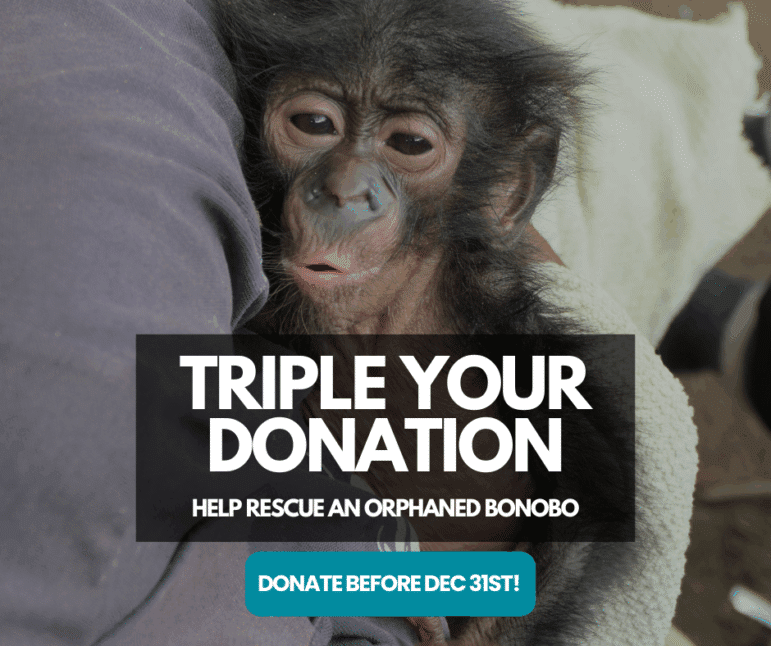FAQ
FAQ Question Topics
FAQ: Volunteer, Visit, Work
We welcome visitors but volunteer opportunities at the sanctuary in the DRC are rare. And for the safety of the bonobos, we don’t have any volunteer positions that involve contact with them.
At times we can accept long-term volunteers (2 weeks or longer) who can offer professional services such as veterinary care, medical care in the field (in rural Congo), or services such as videographers, electricians, landscapers/gardeners, and builders. Also, our U.S. office in Durham, N.C., occasionally needs volunteers for communications and fundraising support.
To offer a service, please complete this short form.
Caring for orphaned baby bonobos is a full-time job. In addition, local residents are important partners in our conservation work. For these reasons, we hire only Congolese people to be bonobo surrogate moms.
We do not currently have any available job opportunities for people who are not local to the DR Congo. If we do have anything available for people outside the DRC, we will announce it on social media and on our website and you are welcome to apply!
Yes. We offer both daily tours as well as an exclusive opportunity for visitors to stay at the sanctuary for up to two weeks. Please see our Visit page to learn more about both options.
You will be able to get very close if you visit the sanctuary, however, we do not allow direct contact with visitors due to the high risk of contagion (from humans to bonobos). Our goal is to release as many bonobos to the wild as we can, and for that reason, once bonobos leave the nursery they have contact with humans only when it is necessary for their survival.
We welcome research proposals from PhD students, and in some cases, master’s students. Proposals should be for studies lasting three months or less. You can submit an abstract and cover letter, along with a letter of recommendation from your professor, to [email protected].
FAQ: Helping Bonobos
Make a donation! However, we recognize not everyone can give in this way. Another way is to become a Bonobo Champ. You can use our secure, online platform to run your own fundraising campaign. It’s easy!
You can share our posts and invite your friends to follow us on Facebook, Instagram, BlueSky and more. IMPORTANT NOTE: PLEASE credit and tag Lola ya Bonobo/Friends of Bonobos and avoid using any language or messaging accompanying our photos/videos that supports or promotes bonobos being viewed as pets. Bonobos an endangered species, and keeping them as pets is illegal and tragic for them. If you have any questions about what is appropriate, feel free to ask!
Yes! Please contact our Director of Philanthropy and ask about becoming a Mosungi. The Mosungi program allows donors to support and get updates on a particular bonobo. Another option is to join The Fellowship, our group of steadfast monthly givers. In the Fellowship, you become part of our community that is providing critical, ongoing, and stable support for all of our bonobo conservation work.
Yes! Please visit our shop: www.shopbonobos.org
All products are made from natural materials and powered by renewable energy and every product is designed to be sent back and remade into new products once they’re worn out – so there’s no waste.
The proceeds from every purchase support Lola ya Bonobo Sanctuary, and wearing your bonobo shirt is an easy way to spread awareness. When your friends ask, “What’s a bonobo,” you can let them in on the secret… bonobos may be the least known of the great apes, but we share 98.7% of our DNA with them. And they need our help!
Head to our website to see all designs and order your bonobo merch now!
FAQ: Bonobo Life at Lola
Approximately $12-$14 USD per bonobo per day.
Approximately 70.
When bonobo orphans are rescued from poachers, they often arrive at Lola with problems such as internal and external parasites, dehydration, and malnourishment. They also suffer from psychological trauma due to violent separation from their mothers. At Lola, upper respiratory infections and the flu are the main risks to the bonobos, as these types of infections spread quickly in groups. Another less common risk is encephalomyocarditis virus (EMCV), which is believed to be spread by rats and has no specific treatment. We keep cats at Lola to help keep the rodent population down.
Enrichment often involves bonobos having to figure out different methods of obtaining their food. We stuff popcorn kernels stuffed into hollowed-out bamboo and hide nuts and sugarcane inside boxes. Other enrichment include swings, trampolines, climbing ropes, and hammocks that bonobo orphans use in the nursery.
FAQ: Rewilding Bonobos
Twenty-seven.
Bonobos take time to grow up, just like humans, and they typically stay at Lola for years. Some will remain at the sanctuary for their entire lives. Whether a bonobo is returned to the wild, and when, depends on many factors including individual bonobo health or disability, social relationships within the bonobo groups, events occurring in DRC, and human and financial resources for our rewilding program.
We look for a cohesive group headed by a mature and dynamic female, with a good range of male and female youngsters. We also watch for bonobo readiness: In the wild, females typically will seek to separate from their birth mother’s group sometime in their teen years.
We release bonobos at Ekolo ya Bonobo Community Reserve in Équateur Province, about 500 miles by plane from Lola ya Bonobo sanctuary. The protected reserve comprises 120,000 acres of dry and swamp forest, land traditionally used by the Baenga, Lisafa and other communities, who are our partners on the project. We have a field station in nearby Basankasu.
FAQ: About Friends of Bonobos
Les Amis des Bonobos du Congo (ABC) is an international organization with sister associations in the US, France, and the UK. This website is managed by our US branch. In the US, donors get a tax deduction for donating to nonprofits such as ours. Non-US citizens often choose to give to Friends of Bonobos/Lola ya Bonobo through PayPal.
If you prefer to give to one of the other sister associations, please go to our Contact page to find out how. If you would rather donate directly to our DRC bank account, please email us at [email protected] and we will help you make that happen. Thank you so much for your questions and for your support!
Oui! Voila le site web et Facebook en Francais.
FAQ: Bonobo Facts
Only in the Democratic Republic of Congo.
Bonobos are an endangered species and protected by law. The main threats to them are illegal hunting for the bushmeat and pet trades and habitat loss due to deforestation.
Bonobo families are centered around females. Sons maintain lifelong relationships with their mothers, while daughters eventually leave the family to find or form a new group. Within groups, females can gain status as they age and have more offspring. Furthermore, female-female bonds are key to their peaceful communities, because they join forces to fend off any aggressive males.
Bonobos have been seen to share food with bonobos outside of their families, without any incentives. When shown videos of other apes yawning, bonobos also yawned, a display of empathy common among humans as well. At Lola bonobos frequently hug and comfort another bonobo who is ill or new to the sanctuary.
Perhaps 5,000 to 17,000 bonobos remain in the wild. The exact number is unknown, however, experts say there may be three generations left in the wild at the current rate of decline. Eco-guards are in place to deter poachers and protect bonobos in some of the forests in the DRC. Read our blog post to learn why it’s hard to estimate how many bonobos are left in the wild.
We don’t know for sure, but because bonobo groups are cohesive and stick together in the face of threat, estimates are that a dozen or more adults may be killed for each bonobo orphan rescued from poachers.
Bonobos are often mistaken for chimpanzees, but there are many differences between the two. Bonobos live only in the Democratic Republic of Congo, whereas chimps can be found across West and Central Africa. Bonobos live in female-dominant societies, while chimps live in male-dominated societies in which there is a clear hierarchy amongst the male chimps. Bonobos have never been seen to exhibit lethal aggression toward one another, whereas chimps have. Physically, bonobos tend to have a longer, leaner body structure while chimps tend to be more compact. For more, please read our blog series on bonobo and chimpanzee differences!



